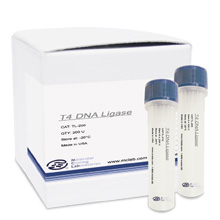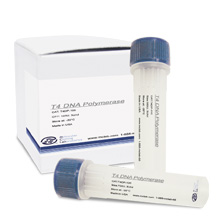-
DNA/RNA Ligases, Enzymes, Next-Generation Sequencing, NGS Enzyme & Amplification Technology
T4 DNA Ligase
T4 DNA Ligase catalyzes the formation of a phosphodiester bond between juxtaposed 5′-phosphate and 3′-hydroxyl termini in duplex DNA or RNA using ATP as a cofactor.
-
Enzymes, Mesophilic DNA Polymerases, Next-Generation Sequencing, NGS Enzyme & Amplification Technology
T4 DNA Polymerase
T4 DNA Polymerase catalyzes the extension of a primed DNA template in the 5′→ 3′ direction. This enzyme exhibits a powerful 3′→ 5′ exonuclease activity; it lacks any inherent 5′→…
-
DNA/RNA Ligases, Enzymes, Next-Generation Sequencing, NGS Enzyme & Amplification Technology
T4 RNA Ligase 1 (ssRNA Ligase)
T4 RNA Ligase 1 catalyzes the ligation of a 5′ phosphoryl-terminated nucleic acid donor to a 3′ hydroxyl-terminated nucleic acid acceptor through the formation of a 3’→5′ phosphodiester bond, with…
-
DNA/RNA Ligases, Enzymes, Next-Generation Sequencing, NGS Enzyme & Amplification Technology
T4 RNA Ligase 2 (truncated) (RNL2)
MCLAB’s truncated T4 RNA Ligase 2 was developed specifically for demanding Next-Generation RNA Sequencing applications. The truncated ligase 2 specifically ligates the adenylated 5´ end of an adapter to the…
-
DNA/RNA Ligases, Enzymes, Next-Generation Sequencing, NGS Enzyme & Amplification Technology
T7 DNA Ligase
T7 DNA Ligase catalyzes the formation of a phosphodiester bond between a 5′ phosphate and a 3′ hydroxyl termini in duplex DNA. The enzyme joins blunt end and cohesive end…
Toll Free: 1-(888)-MCLAB-88 Tel: 1-(650)-871-8771
- Home
- Shop
- Products
- Next-Generation Sequencing
- NGS Enzyme & Amplification Technology


